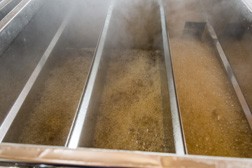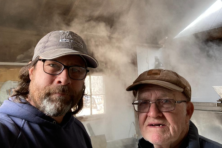A Sweet Hobby: Orrick Shares Maple Syrup Knowledge
- Share
- Tweet
- Pin
- Share
Some guys hunt. Some fish. Some golf. Jonathon Orrick collects sap from maple trees and makes syrup.
“This is where I blow my money. It’s a glorified hobby,” Orrick said, standing in the sugar shack he built last winter behind his Sister Bay home. “I love the local food movement. I love the fact that maple syrup is a sustainable product. Some people have been tapping the same trees for years, the same trees that their great-great-grandparents tapped.”

Orrick has collected sap and cooked it into syrup for years, but only last year decided to pull the trigger and build a sugar shack to house an efficient evaporator.
“There’s something kind of romantic and nostalgic about being able to tap your own tree, even if you don’t have the capacity to cook it,” he said. “There is no limit to how you can cook down maple sap. You can do it on a wood stove. You can do it on a turkey fryer. My first attempts were on a concrete block creation that had a little pan that sat on it. It took us the entire season of throwing sticks and twigs underneath to get a gallon of syrup. That’s how we started, and we stepped up and we stepped up.”
While he was ready to roll with the new sugar shack and efficient evaporator last year, the weather didn’t cooperate. With an extended polar vortex that wouldn’t release its grip, it was a bad spring for collecting sap.
“Last year at this time we were tapped but we weren’t getting anything. Last year was such a goofy, goofy year,” Orrick said. “Days when you thought you would have a good sap day, you didn’t. Then you’d have a couple of good days and a freeze would come again for three, four days. So we had this up and down.

I’m hoping this year will be a little more moderate.”
According to researchers 2015 should be a good year for syrup.
“Some of the reports out east are talking about it being a banner year,” Orrick said. “The scientists that study the maple world will tell you that it’s related to leaf and seed production and they’re thinking it will be a pretty decent year. I don’t know how all that works. I’ll just take their word for it. Looking at the long-range forecast, we’ve got that freeze-thaw cycle, so I believe we’ll be primed for a pretty good season, but you never know. It’s Mother Nature. ”
While the week of March 8-14 seemed ideal for sap collecting with sunny days and cool nights, the sap was running slowly.

“I think the frost dove really deep this year,” Orrick said. “We didn’t have much snow cover and what we had was very powdery, so the frost drove pretty deep into the ground. I think the root zones are frozen and the trees were still a little frozen. I think it takes a couple of warm days to kind of prime the pump, if you will, or get those trees moving, some moisture in the ground, some melt water in the ground, get the root zones to warm up a little bit.”
In his own back yard, Orrick has blue bags hanging from the spouts in the maple trees, but he collects at two other locations using a tubing system. He has 192 tube taps at one location and 140 at another, which is a record for him.
“Before this the most we’ve had is 170 taps,” he said. “The reason I don’t use the tubes here, I really don’t want to look at it in my back yard.”
But he has another reason for using the bags for collection at his home. Orrick likes to share his maple-syrup making skills with others.
“We get a fair amount of people that just stop by, and they want to do something. When we’re cooking, they say, ‘What can I do?’ So they can collect bags of sap. It gives them something to do with the process,” he said.
The weekend of March 7-8, Orrick held a workshop for anyone interested in learning about tapping trees.
“Ten people showed up,” he said. “I sent home with two of them some of these bags and taps. They were going to go home and drill some holes in their own maples and collect, and even bring it back here or cook it down themselves. We love to get people addicted to this.”
He also likes to involve his four daughters in the process.
“The kids come out and help me tap and collect,” he said. “I usually have a mug out here. I take the sweetened sap – it’s not really syrup and it’s not really sap – we call it ‘super sweet.’ I’ll always have a mug of that cooling on the shelf so when they come out they can take a little nip. It keeps them coming back.”

He said there is typically a three- to four-week season when the sap is flowing.
“When we’re flowing, we’re boiling every day that we have sap,” Orrick said. “And then we’ll do boiling workshops. We just do an open house. Any day we are cooking, anybody’s welcome to stop over. People are welcome to participate in any way, shape or form.”
He uses soft wood – cedar and pine – because they give more flame than hard woods.
“For our size and what we want to do, this is a pretty neat little rig,” Orrick said of his evaporation unit. “It’s pretty neat. The doors on the cupola open up. There is so much steam coming out of this pan it looks like it’s on fire. In fact, there are reports in many areas where people have called in sugar shacks. They see it across the field and it looks like it’s on fire. It’s pretty impressive to see. This system is designed to really get efficient evaporation.”
Orrick used to sell his syrup at various farmers markets, but has given those up.
“Now we use Facebook and some other things. Plus we have people who know we’re doing it. Every year we have repeat customers who come back,” he said. “This is a hobby for me, but I do need to make money to cover the investment. I don’t view this with a business mind. I’ve got some other businesses where every decision is viewed through a business filter, but this is my hobby.”
Well, there is another reason for selling the syrup.
“The profit for our syrup goes into our adoption fund,” Orrick said. “We’ve adopted once in the past and we’re in the system now for one more adoption, and our profit goes to fund the adoption. Once we finalize our adoption and get it paid, I’m not sure what my wife has up her sleeve, but we may end up doing something where we help other people adopt as well.”


